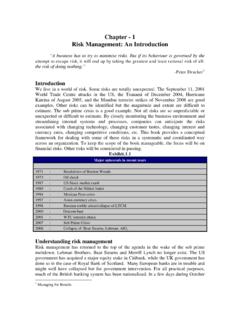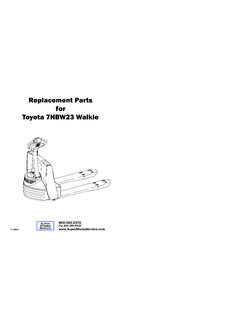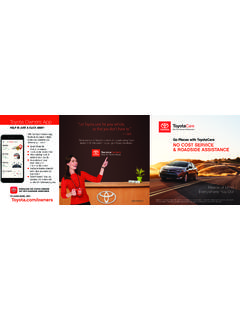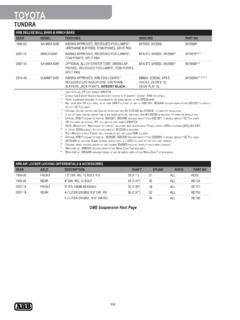Transcription of The Toyota Way - A.V. Vedpuriswar
1 The Toyota Way Jeffrey K Liker Tata McGraw-Hill, 2004 Introduction It is obvious that there is something special about Toyota . The Japanese automobile manufacturer currently has the fastest product development process in the world. New cars and trucks take 12 months or less to design, while competitors typically require two to three years. Toyota has phenomenal quality levels, that rivals can only dream of matching. Toyota has turned operational excellence into a strategic weapon not merely through tools and quality improvement methods but a deeper business philosophy rooted in understanding of people and what motivates them. Its success is ultimately based on its ability to develop leaders, build teams, and nurture a supportive culture, to devise strategy, to build deep supplier relationships, and to maintain a learning organization. Jeffrey Liker is an authority on Toyota .
2 Liker gives an excellent account of how Toyota has become one of the best managed companies in the world. He also outlines how other companies can learn from Toyota and improve their way of doing business. This book makes excellent reading for leaders building learning organizations. The Toyota Production System Toyota developed the Toyota Production System after World War II. While Ford and GM used mass production, economies of scale, and big equipment to produce as many parts as possible, as cheaply as possible, Toyota 's market in post-war Japan was small. Toyota also had to make a variety of vehicles on the same assembly line to satisfy its customers. By making lead times short and focusing on keeping production lines flexible, Toyota realized it could actually get higher quality, better customer responsiveness, better productivity, and better utilization of equipment and space.
3 A basic premise of mass production is that machine downtime is obvious waste. A machine shut down for repair is not making parts that could make money. But TPS has challenged this notion. Often the best thing you can do is to idle a machine and stop producing parts. Over production, is a fundamental waste in TPS. Often it is best to build up an inventory of finished goods in order to level out the production schedule, rather than produce according to the actual fluctuating demand of customer orders. Leveling out the schedule (heijunka) is a foundation for flow and pull systems and for minimizing inventory in the supply chain. Leveling production smoothes out the volume and mix of items produced so there is little variation in production from day to days. Often it is best to selectively add and substitute overhead for direct labor.
4 When waste is stripped away from value-adding workers, high-quality support has to be provided for 2 them. It may not be a top priority to keep your workers busy making parts as fast as possible. Companies should produce at the rate of customer demand. Working faster just for the sake of getting the most out of workers may be counter productive. It is best to selectively use information technology and often better to use manual processes even when .automation is available and would seem to justify its cost in reducing your headcount. People are the most flexible resource. The manual process must be streamlined before it is automated. TPS starts with the customer, by asking, "What value are we adding from the customer's perspective?" Because the only thing that adds value in any type of process- be it in manufacturing, marketing, or a development process-is the physical or information transformation of that product, service, or activity into something the customer wants.
5 TPS is all about commitment to continuously investing in its people and promoting a culture of continuous improvement. When Toyota sets up assembly lines, it selects only the best and brightest workers, and challenges them to grow in their jobs by constantly solving problems. Similarly, Toyota staffs sales, engineering, service parts, accounting, human resources, and every aspect of the business with carefully selected individuals and empowers them to improve their processes and find innovative ways to satisfy their customers. Toyota is a true learning organization that has been evolving and learning for most part of a century. Many companies have embraced lean tools but do not understand what makes them work together in a system. They do not understand the power behind true TPS. That lies in Toyota s continuous improvement culture.
6 A Brief History The roots of the Toyota Way can be traced back to Sakichi Toyoda, a tinkerer and inventor, who grew up in the late 1800s in a remote farming community outside of Nagoya. As a boy, Toyoda learned carpentry from his father and started designing and building wooden spinning machines. In 1894 he began to make manual looms that were cheaper and more efficient than existing looms. Toyoda s mother, grand mother, and their friends worked hard spinning and weaving. To relieve them of this punishing labor, he set out to develop power-driven wooden looms. Toyoda eventually developed sophisticated automatic power looms. Among his inventions was a special mechanism to automatically stop a loom whenever a thread broke. This invention led to the concept of jidoka (automation with a human touch). If Sakichi Toyoda put his mark on the industrial world through loom making, Just-In-Time was his son Kiichiro Toyoda's contribution.
7 His ideas were influenced by a study trip to Ford's plants in Michigan to see the automobile industry Kiichiro was also inspired by the supermarket system of replacing products on the shelves just in time as customers purchased them. 3 After World War II, the Americans realized the need for trucks in order to rebuild Japan and even helped Toyota to start building trucks again. As the economy gained momentum, Toyota had little difficulty getting orders for automobiles. But rampant inflation made money worthless and collections became very difficult. As the cash crunch worsened, Toyota adopted strict cost-cutting policies, including voluntary pay cuts by managers and a 10 percent cut in pay for all employees. Finally, Kiichiro had to ask for 1,600 workers to "retire" voluntarily. This led to work stoppages and public demonstrations by workers. Kiichiro accepted responsibility for the failure and resigned as president, even though in reality the problems were well beyond his or anyone else's control.
8 Many workers voluntarily left the company and labor peace was restored. However, his tremendous personal sacrifice had a profound impact on the history of Toyota . Even before the second world war, Toyota had realized that the Japanese market was too small and demand too fragmented to support the high production volumes in the Toyota realized that to survive in the long run, it would have to adapt the mass production approach for the Japanese market. Bigger rivals like Ford had tons of cash and a large and international market. Toyota had no cash and operated in a small country. With few resources and capital, Toyota needed to turn cash around quickly. Ford had a complete supply system, Toyota did not. Toyota didn't have the luxury of taking cover under high volume and economies of scale afforded by Ford's mass production system.
9 It needed to adapt Ford's manufacturing process to achieve simultaneously high quality, low cost, short lead times, and flexibility. Toyota needed to churn out low volumes of different models using the same assembly line, because consumer demand in Japan was too low to support dedicated assembly lines for one vehicle. Most businesses use processes that are filled with waste, because work in Step 1 is performed in large batches before it is needed by Step 2. This "work in process" must then be stored and tracked and maintained until needed by step 2. TPS is a "pull system", in which every step of every manufacturing process has the equivalent of a "gas gauge" built in, (called kanban), to signal to the previous step when its parts need to be replenished. This creates "pull" which continues cascading backwards to the beginning of the manufacturing cycle.
10 Identifying waste The first question in TPS is always" What does the customer want from this process?" This defines value. Through the customer's eyes, a process is observed and the value-added steps are separated from the non-value-added ones. Toyota has identified various types of non-value-adding waste: 1. Overproduction. Producing items for which there are no orders. This leads to overstaffing and storage and transportation costs. 4 2. Waiting (time on hand). Workers merely serving to watch an automated machine or having to stand around waiting for the next processing step, tool, supply, part, etc., or having no work because of stockouts, lot processing delays, equipment downtime, and capacity bottlenecks. 3. Unnecessary transport or conveyance. Carrying work in process (WIP) long distances, creating inefficient transport, or moving materials, parts, or finished goods into or out of storage or between processes.






